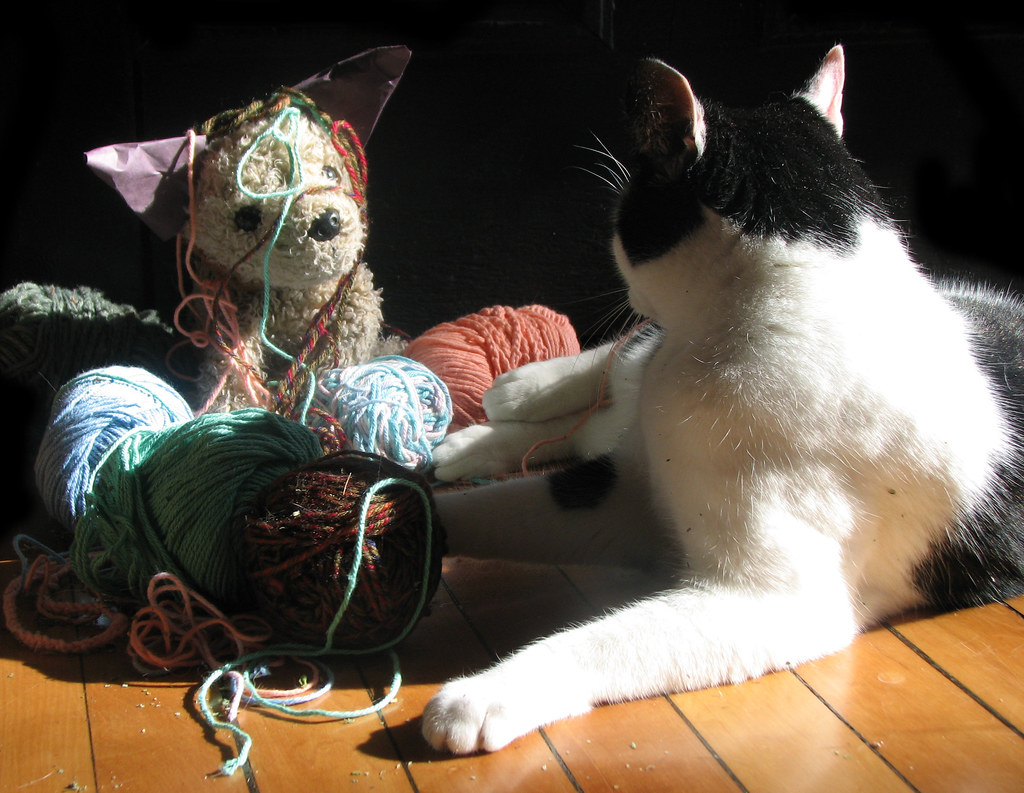Key Takeaways
-
Stimulation is essential for indoor cats to prevent boredom and maintain physical and mental health.
-
Signs of an under-stimulated cat include destructive behavior, overeating, and lethargy.
-
Cats need a variety of toys and activities to keep them engaged, including vertical spaces and interactive play.
-
Daily exercise routines and brain games like puzzle feeders can greatly enhance your cat’s well-being.
-
Automated toys and DIY solutions can provide entertainment when you’re not around to engage with your cat.

“Day 32: Cats | After my Valentine’s Day …” from www.flickr.com and used with no modifications.
Optimize Your Indoor Cat’s Well-being
Keeping your indoor cat mentally and physically stimulated isn’t just a luxury—it’s a necessity. Cats are naturally curious and playful creatures, and without proper stimulation, they can develop a range of behavioral and health issues. But fear not! With a little creativity and understanding of your feline friend’s needs, you can create a stimulating environment that keeps them fit and happy.
The Importance of Stimulation for Indoor Cats
Indoor cats often lack the natural stimuli that outdoor cats encounter. This can lead to boredom and stress, which in turn can manifest as health and behavioral problems. To prevent this, it’s crucial to provide indoor cats with appropriate stimulation that caters to their natural instincts to hunt, climb, and explore. A well-stimulated cat is not only happier but also healthier, as mental engagement can prevent issues such as obesity and depression.
Common Signs of an Under-Stimulated Cat
How can you tell if your indoor cat is craving more stimulation? Here are a few tell-tale signs:
-
Over-grooming or other obsessive behaviors
-
Overeating or lack of appetite
-
Lack of interest in their surroundings
-
Excessive sleeping or restlessness
-
Destructive behavior such as scratching furniture
If you notice these behaviors, it’s time to step up your cat’s activity levels. Let’s explore how you can do that.
Design a Feline-Friendly Space
Cats love to explore and make the most of their environment. Designing a cat-friendly space means integrating areas for play, rest, and observation. Here’s how to do it:
Choose the Right Toys for Energetic Play
When it comes to toys, variety is key. Cats can quickly grow tired of the same old playthings. Offer a mix of toys that encourage different types of play, from chasing and pouncing to batting and biting. Consider these options:
-
Feather wands that mimic the movement of birds
-
Small, lightweight balls that can be batted around
-
Interactive laser toys that get your cat moving
Remember, safety first. Always supervise your cat with string toys and ensure there are no small parts they can swallow.
Construct a Vertical Playground
Cats love to climb—it’s in their nature. A vertical playground can include cat trees, shelves, or wall-mounted steps. These structures not only provide exercise but also a high vantage point from which your cat can survey their kingdom. Most importantly, they mimic the climbing and perching cats would naturally do outdoors.
Safe Outdoor Spaces
While the outdoors can be dangerous for cats, you can still provide them with a taste of nature. Enclosed patios or “catios,” window perches, and supervised leash walks are all great ways to safely introduce your cat to the outside world. They can bask in the sun, watch birds, and breathe fresh air—all under your watchful eye.
Interactive play is not just about fun; it’s about mimicking the hunt. It’s about awakening those instincts that keep your cat’s mind sharp and their reflexes quick. Here’s how you can make playtime more engaging:
Pick Fun and Interactive Toys
Think of toys that you can use to play together with your cat. A wand toy with feathers or a soft toy at the end can dance and dart in ways that mimic prey, providing a thrilling chase for your cat. Interactive toys not only help your cat release pent-up energy but also strengthen the bond between you two.
But just having toys isn’t enough. Cats, much like humans, crave novelty. If you’ve noticed your cat losing interest in their toys, it’s time to shake things up.
Rotate Toys to Maintain Interest
Keeping the same toys out all the time can lead to boredom. To keep things fresh, rotate your cat’s toys every few days. This way, each toy is a new adventure, and they’ll maintain their appeal for much longer. Besides that, this strategy helps prevent the clutter of toys that can happen if too many are available at once.
Cat Fitness: Keep Your Cat Moving
Physical activity is as vital for cats as it is for us. It keeps them fit, prevents obesity, and can reduce the risk of health issues. Here’s how to incorporate more movement into your cat’s day:
Creative Exercise Ideas
Exercise doesn’t have to be a chore—for you or your cat. Here are some creative ways to get your feline friend moving:
-
Use a laser pointer to lead your cat on a chase—up furniture, across the floor, and around corners.
-
Throw a ball up the stairs and encourage your cat to chase it down.
-
Set up a cat agility course using tunnels, hoops, and other obstacles.
Always supervise play with lasers to ensure your cat doesn’t injure themselves, and be sure to reward them with a tangible toy at the end, so they have the satisfaction of a ‘catch’.
Setting Up Daily Exercise Routines
Consistency is key when it comes to exercise. Try to set aside time each day for your cat’s physical activity. It could be before meals, making it a sort of ‘hunt’ for their food, or any other time that fits into your schedule. The routine will help your cat burn energy regularly, and they’ll start to look forward to these sessions.
Brain Games: Challenge Your Cat’s Mind
Physical fitness is one thing, but don’t forget about mental gymnastics. Brain games can keep your cat’s mind sharp and provide much-needed stimulation. Let’s dive into some brain-boosting activities:
Puzzle Feeders and Food Games
Puzzle feeders are a fantastic way to engage your cat’s brain and make them work for their food. These can range from simple balls that release kibble when rolled to more complex puzzles that require your cat to move pieces around to access their treats. Food games can include:
-
Hiding treats around the house for your cat to find.
-
Using a treat-dispensing toy that they have to manipulate to release food.
-
Creating a homemade puzzle with a cardboard box and some holes for treats.
These games tap into your cat’s natural hunting instincts and can help prevent overeating by slowing down their food intake.
Training Sessions for Mental Engagement
Believe it or not, cats can be trained, and it’s a brilliant way to mentally stimulate them. Clicker training, for example, can teach your cat tricks or useful behaviors, and it’s a fun way to spend quality time together. Start with simple commands like ‘sit’ or ‘high five,’ and gradually work up to more complex tasks. It’s not just dogs that can learn new tricks!
Automating Fun: Keeping Cats Entertained Alone
We can’t always be around to entertain our cats, but that doesn’t mean they have to be bored. Automated toys can provide entertainment and exercise when you’re not home. Here’s how to keep the fun going even when you’re away:
The Best Automated Toys for Cats
There’s a wide variety of automated toys available that can keep your cat busy. Some of the best options include:
-
Motorized mice that scurry around unpredictably.
-
Electronic bird simulators that chirp and flutter.
-
Interactive laser toys that can be programmed to turn on and off at set times.
These toys are designed to engage your cat’s hunting instincts and provide hours of fun. Just make sure to check the safety of these toys and remove any potential hazards.
DIY solutions can also be a great way to stimulate your cat. For instance, a simple cardboard box with holes cut into it can become an exciting puzzle for your cat to explore.
DIY Stimulation Ideas When You’re Not Around
Sometimes the simplest solutions are the most effective. You don’t always need high-tech gadgets to keep your cat entertained. Try these DIY ideas:
-
Leave out a cardboard box with holes cut in the sides—cats love to explore and hide in these makeshift forts.
-
Create a ‘fishing pole’ with a stick, string, and a toy or feather attached to the end. Secure it so that it dangles and sways enticingly.
-
Scatter catnip or treats inside a paper bag or under a rug to encourage foraging behavior.
These ideas can stimulate your cat’s curiosity and keep them busy while you’re away. Plus, they’re fun and easy to set up!
Frequently Asked Questions (FAQ)
How long should I play with my indoor cat each day?
Every cat is different, but a good rule of thumb is to aim for at least 15 to 30 minutes of dedicated playtime each day. This can be broken up into shorter sessions if your schedule doesn’t allow for one long play period. The key is to ensure your cat gets enough exercise and mental stimulation to stay healthy and happy.
Why does my cat get bored of their toys?
Cats, much like people, crave variety. They get bored if they’re presented with the same stimuli over and over again. To keep things interesting for your cat, rotate their toys regularly and introduce new ones occasionally. This way, each toy remains a novel and exciting challenge for them to explore.
Is it safe to let my indoor cat outside?
While there are benefits to allowing your cat to experience the outdoors, there are also risks such as traffic, predators, and disease. If you do decide to let your cat outside, consider supervised outings or a secure outdoor enclosure, commonly known as a ‘catio,’ to minimize the risks while still providing some outdoor stimulation.
Can cats get enough exercise indoors?
Yes, indoor cats can get enough exercise, but it requires a bit of effort from their human companions. Use toys, interactive play, and cat furniture to encourage natural behaviors like climbing and hunting. Creating an engaging indoor environment will help your cat stay active and healthy.
-
Interactive play with toys like wands or lasers.
-
Food puzzles that make them work for their treats.
-
Climbing structures like cat trees or wall shelves.
How can I tell if my cat is mentally stimulated?
A mentally stimulated cat will display behaviors indicative of contentment and curiosity. They will be alert, responsive to their environment, and engage in playful activities. Conversely, a cat that sleeps excessively, shows little interest in play, or exhibits signs of stress, such as over-grooming, may need more mental stimulation. Remember, a stimulated cat is a happy cat!


